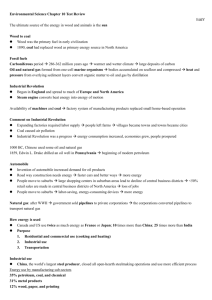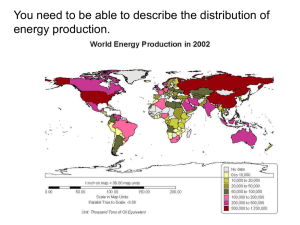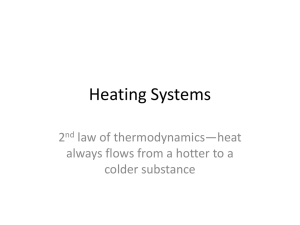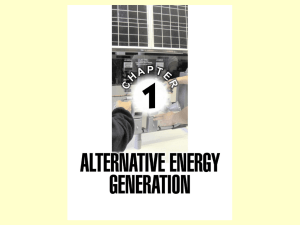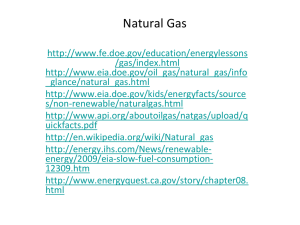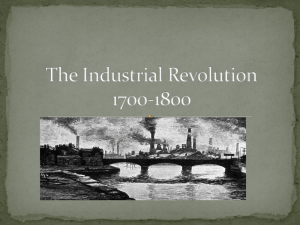Patterns of Energy Consumption
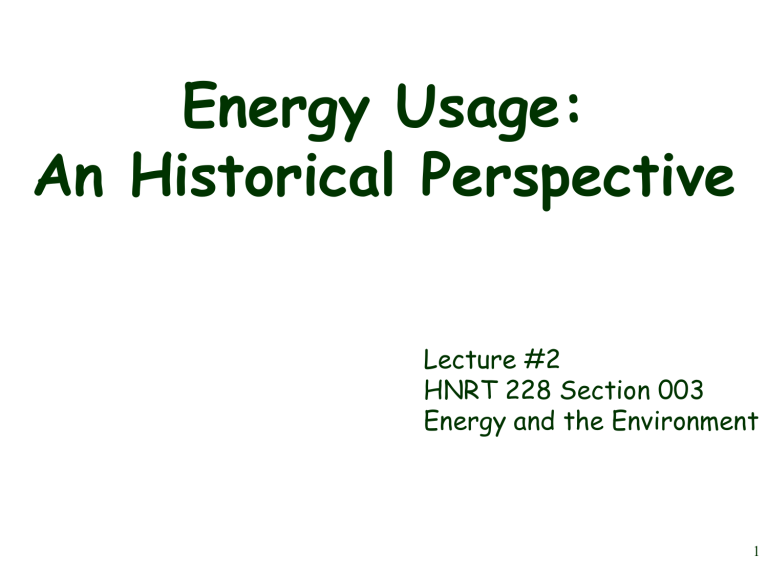
Energy Usage:
An Historical Perspective
Lecture #2
HNRT 228 Section 003
Energy and the Environment
1
F2 Box F1
•
•
•
•
•
In the diagram above, a box is on a frictionless horizontal surface with forces F1 and F2 acting as shown. If the magnitude of F1 is greater than the magnitude of F2, then the box is
A. moving at constant speed in the direction of F1
B. moving at constant speed in the direction of F2
C. accelerating in the direction of F1
D. accelerating in the direction of F2
E. not moving at all.
2
•
•
•
•
•
The metric unit of a Joule (J) is a unit of
A. potential energy.
B. work.
C. kinetic energy.
D. All of the above (A, B, and C) are measured in Joules.
E. None of the above (A, B, and C) are measured in Joules.
3
•
•
•
•
•
Which statement is true about the concept of power?
A. Power is the distance over which work is done.
B. Power is the time at which energy is expended.
C. Power is the work done per unit time.
D. All of the above (A, B, and C) can be said about power.
E. None of the above (A, B, and C) is true about power.
4
•
•
•
•
•
The kilowatt-hour is a unit of
A. power.
B. work.
C. time.
D. area.
E. volume.
5
History of Energy Consumption
•
Biological Energy Sources
–
Initial energy transfer occurs through
–
–
– photosynthesis.
Very early in history humans began to exploit additional energy sources to make life more comfortable.
Human, animal labor
Transportation, cooking, primitive light
6
Energy use - Middle ages
•
•
•
•
•
Wind for sailing
Peat, charcoal, coal on ground for fires – cooking, heat
Water wheels, wind mills for grain grinding
Animal power also
Candles – animal fat & whale oil - light
7
Increased Use of Wood
•
Early civilizations used human muscle power as their primary energy source.
–
Energy provided by burning wood enabled people to cook food, heat living areas, and develop primitive metallurgy.
Dense, rapidly growing settlements outstripped wood production, thus new fuel sources had to be utilized.
1890, coal replaced wood - primary energy source
8
Fossil Fuels
•
Carboniferous period,
(286-362 Mya)
– large deposits of plants, animals, and
– microorganisms.
Led to the formation of fossil fuel deposits.
9
Industrial Revolution - 1875
•
Industrial Revolution - Machines replaced human and animal labor in the manufacture and transportation of goods.
–
Steam engines converting heat energy into forward motion was central to this transformation.
Countries or regions without large coal deposits were consequently left behind.
10
Industrial Revolution
•
Prior to the Industrial Revolution, goods were manufactured on a small scale in private homes – master craftsman
–
Expanding factories = larger labor pools, move to city
200 years, energy consumption increased 8X
*Increased levels of air pollution.
11
iClicker Question
•
Fossil fuels are derived from biological material produced
–
A at the time of the industrial revolution
–
–
–
–
D
E
B
C about 300 million years ago about 1 million years ago about 1 billion years ago at the turn of the previous century
12
Changes in Energy Sources to 2000
13
iClicker Question
•
At the turn of this century (2000) most energy was derived from
–
–
A Coal
B Wood
–
–
–
C Natural Gas
D Oil
E Nuclear Power
14
Role of The Automobile
•
•
Growth of automobile industry led to roadway construction; required energy. Better roads - Higher speeds
Higher speeds - Bigger faster cars = Bigger faster cars - Better roads
Convenience of two-car families - Job growth in automobilerelated industries - Major role in development of industrialized nations.
15
Role of The Automobile
•
Cars altered people’s lifestyle
–
Greater Distance Travel
Sprawling Cities
–
Suburbs
Vacations
16
Role of The Automobile in 2000
17
iClicker Question
•
From the data provided do you think people in New York live closer or further to their place of employment than those people in North Dakota?
–
–
–
A Closer
B Further
C Cannot be determined
18
Growth in the Use of Natural Gas
•
Initially, natural gas was burned as a waste product at oil wells.
–
Before 1940, accounted for less than
10% of energy consumption in United
–
States.
By 1970, accounted for about 30% of
energy needs.
In 2003 accounted for 25% of U.S. consumption.
Primarily used for home heating and industrial purposes.
19
How is Energy Used?
•
•
•
Industrialized nations use energy for:
–
Residential / Commercial uses
–
–
Industrial uses
Transportation
Less developed countries use most energy for residential purposes.
–
Cooking and Heating
Developing countries use much of their energy to develop industry.
20
US use of oil to 2002
21
iClicker Question
•
Oil use in the U.S. has always risen since
1960.
–
–
A True
B False
22
Residential and Commercial Energy Use
•
•
N. America - 16% of energy used for residential and commercial purposes.
–
75% used for air conditioning and heating as well as water heaters.
India - 57% used for residential and commercial purposes.
23
Industrial Energy Use
•
Total amount of energy required in a country’s industrial sector depends on industrial processes in use.
–
Many countries use inefficient processes and could reduce energy consumption by converting to more efficient means.
Need capital investments.
Many less developed countries don’t have the necessary capital.
24
Transportation Energy Uses
•
Per capita energy use for transportation is high in developing countries and highest in highly developed countries.
–
–
Mass Transit systems are most efficient in countries with a dense population.
Most countries heavily tax fuel, increasing the appeal of mass transit.
25
Per capita energy use for transportation
26
Transportation Energy Uses
•
In North America, government policies have kept energy costs low, thus supporting the automobile industry.
–
Private automobiles in N. America consume over 40% of world gasoline production.
North America only accounts for 5% or world population.
27
Electrical Energy
•
•
Most electrical energy is produced as a result of burning fossil fuels.
Because electricity is easily transported and its uses are so varied, electricity is a major world energy source.
–
Industrialized nations have 20% of the world’s population, but use 60% of the world’s electricity.
Per capita use in N. America is 25 times greater than that in lessdeveloped countries.
28
World Electrical Energy Use
29
How does the US compare to others in overall energy use through 2002?
30
The Economics and Politics of Energy Use
•
A correlation exists between energy and productivity.
–
Most industrial societies want to ensure a continuous supply of affordable energy.
–
–
The higher the price of energy, the more expensive goods and services become.
Subsidies help keep energy costs down.
31
Fuel Economy and Government Policy
•
Price of gasoline determined by two factors:
–
–
Purchasing and processing crude oil.
Taxes
Taxes in the U.S. represent less than
30% of retail gasoline price.
40% in Canada
50-75% in Japan and Europe
32
Fuel Economy and Government Policy
•
Governments often charge road users to help build and repair roads by taxing fuel.
–
Can also discourage use via increases.
–
U.S. only raises 60% of monies needed for roads from fuel taxes.
This tends to keep fuel costs low
Encourages consumption
33
Gasoline Taxes and Fuel Cost
34
iClicker Question
•
Which of the following countries has the lowest gas taxes?
–
–
A France
B Germany
–
–
–
C Spain
D Japan
E USA
35
Political and Economic Factors
•
•
During the 1980’s, energy costs in North
America and Europe declined
–
– less concern about energy consumption
1979 - oil ~ $40 / barrel
–
1998 - oil ~ $15 / barrel
Factors determining energy use
–
–
–
Political Stability
Price of Oil
Others?
36
The Importance of OPEC
•
Oil Producing and Exporting Countries
–
–
Twelve members
Control over 78% of world’s estimated oil reserves.
1,000 billion barrels
37
Sources of US oil in 2003
38
Changes in World Energy Consumption
39
Energy Consumption in 2003
•
Over half of world energy consumption is by the 25 member countries of the
Organization for Economic Co-Operation and Development (OECD).
–
Available Energy Sources
Oil 38%
Natural Gas
Coal
26%
24%
40
Energy Consumption Trends
•
•
Energy consumption behavior of most people is motivated by economics rather than a desire to wisely use energy resources.
Over the past several years, world oil prices have been extremely volatile.
–
–
–
Oversupply
OPEC Actions
Persian Gulf War
–
Iraq War
41


